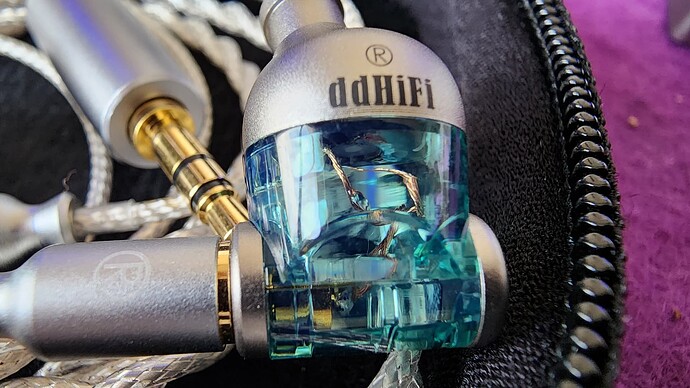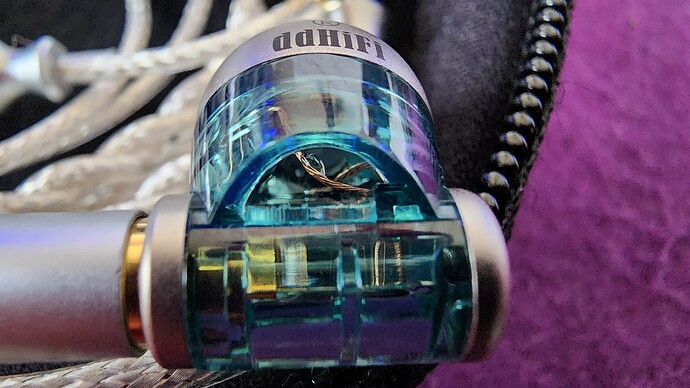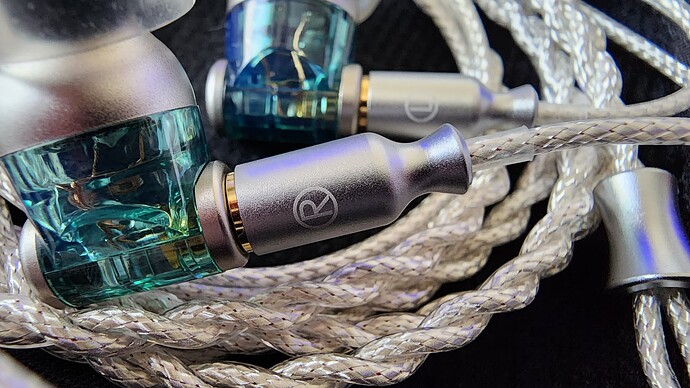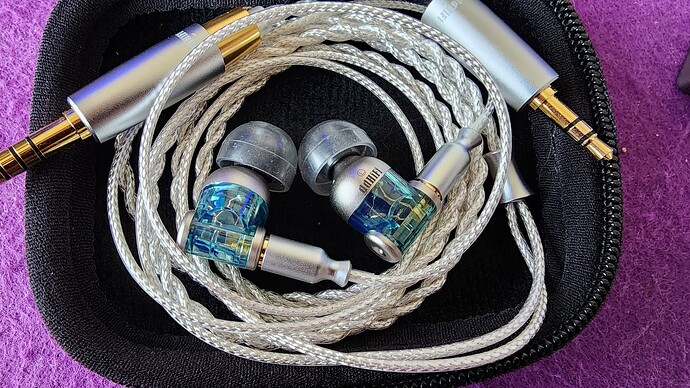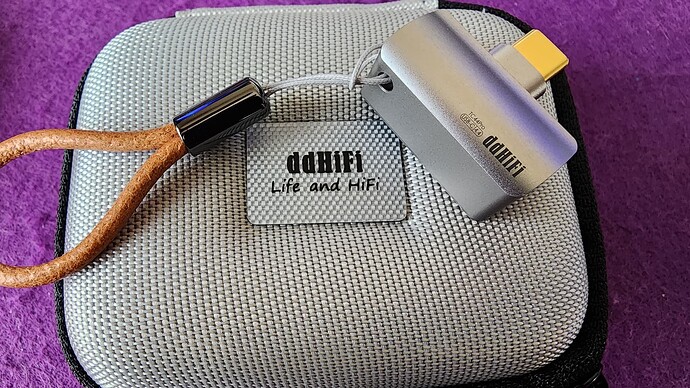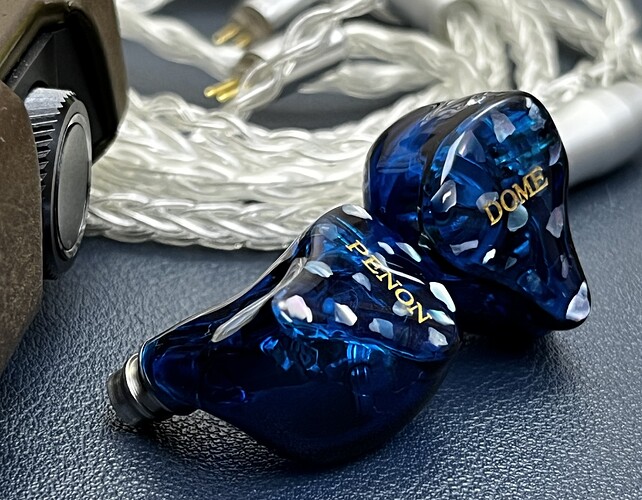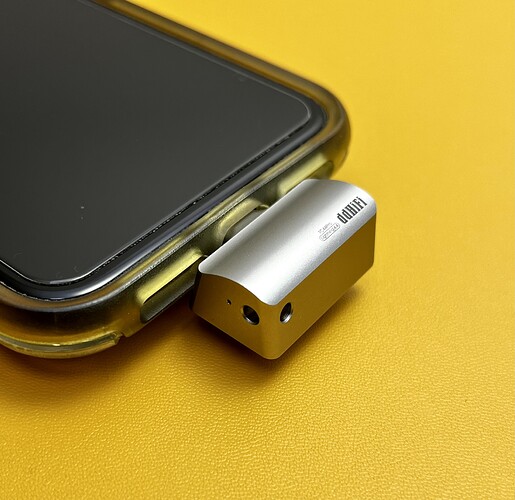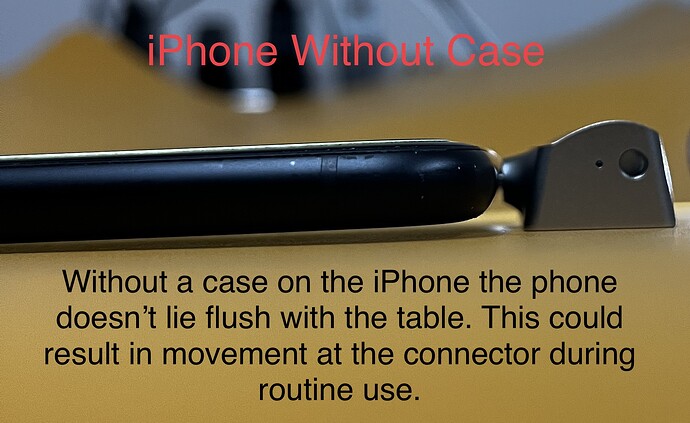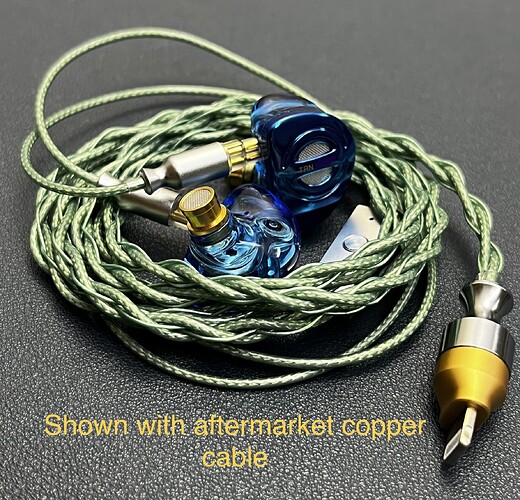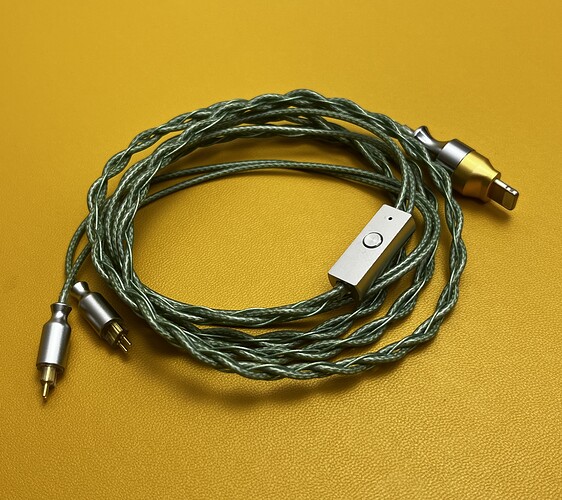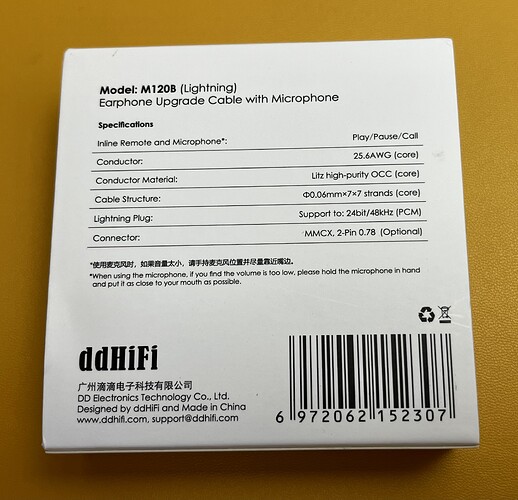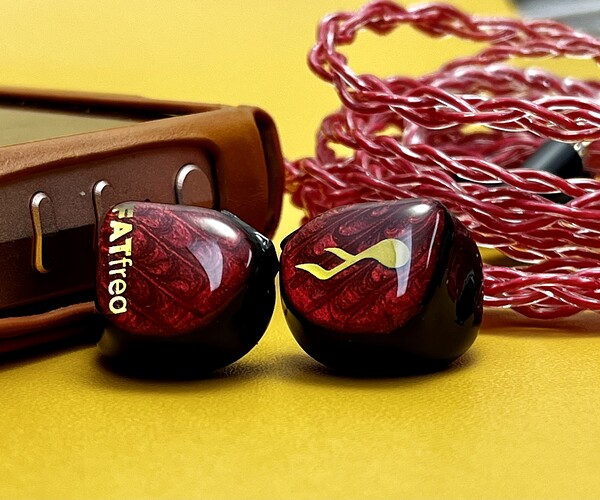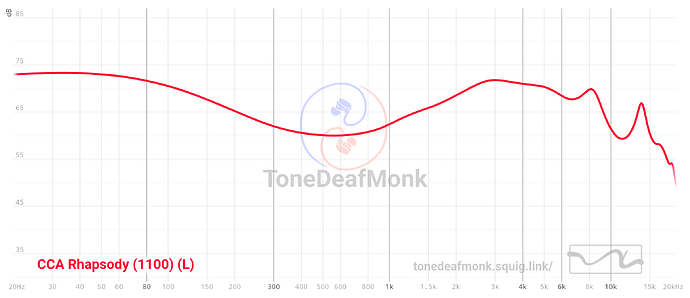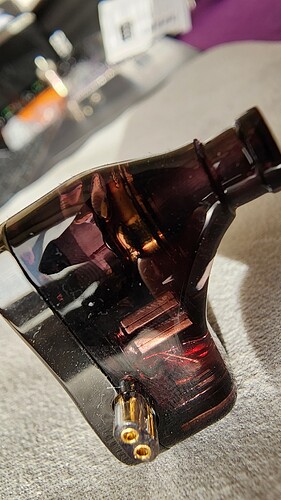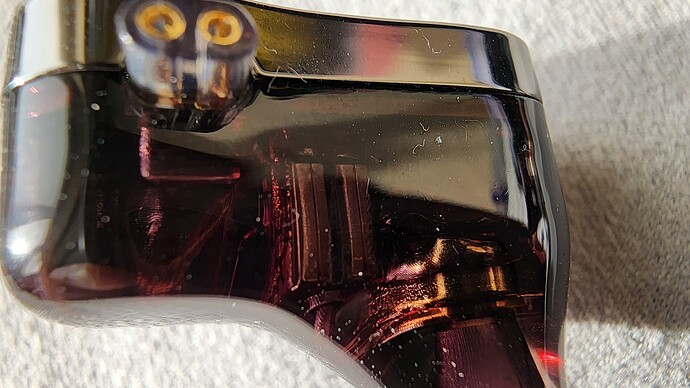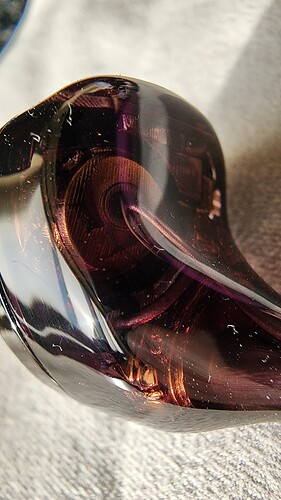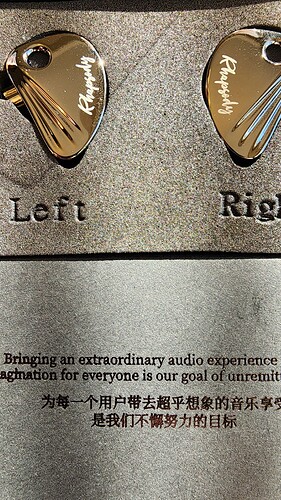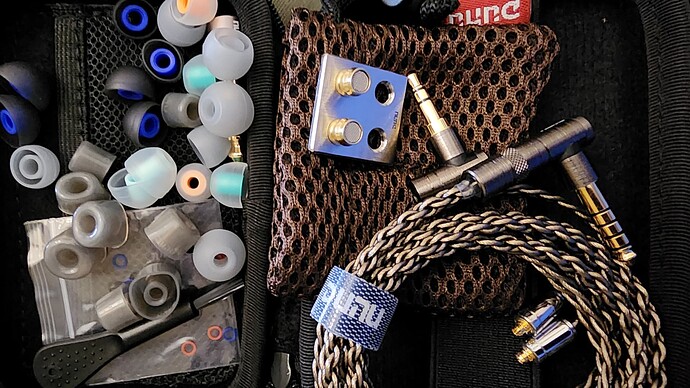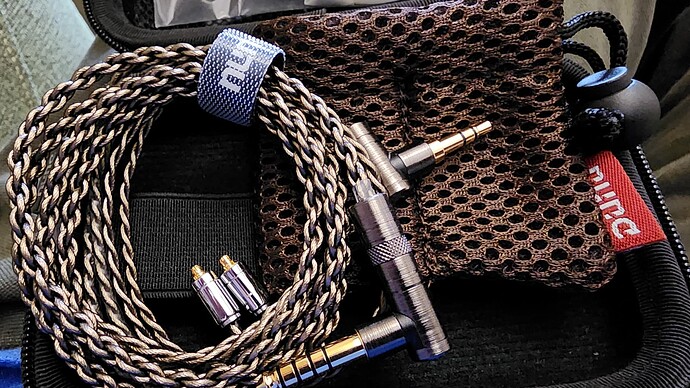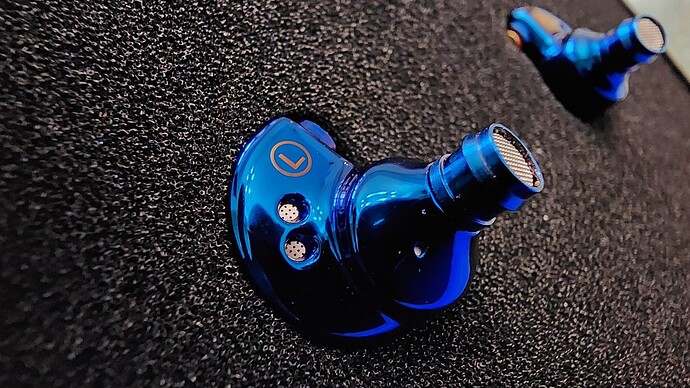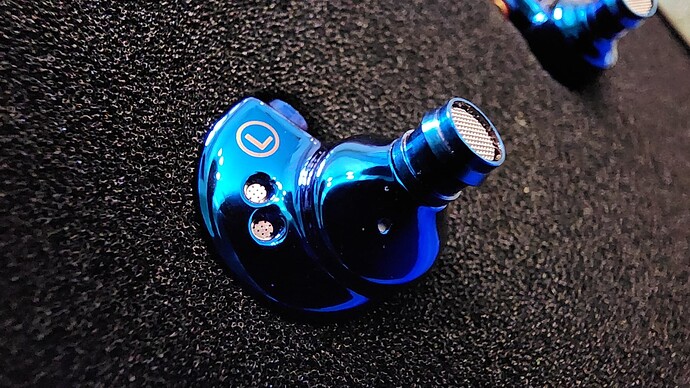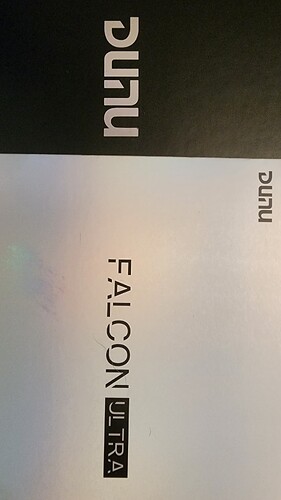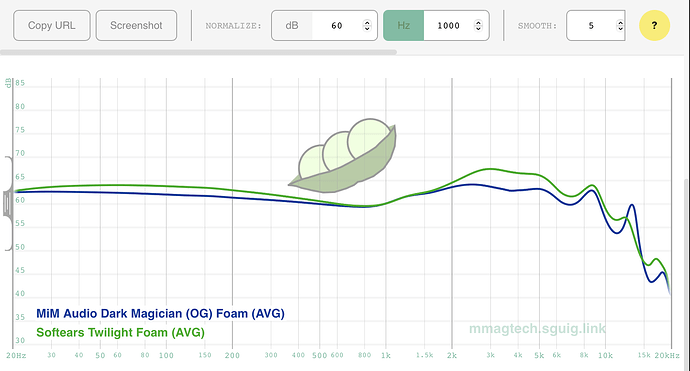Another $8 off on AliEx with the code AEUS8 ($8 off $50).
A really well tuned set of Harmanish Double Dynamic Driver Set!
AOSHIDA E20 $50
https://a.aliexpress.com/_msUya8k
![]() Well tuned Harman for the masses
Well tuned Harman for the masses
![]() Bass texture and slam worth of a Beryllium 10mm DD
Bass texture and slam worth of a Beryllium 10mm DD
![]() Smooth and extended top end a real standout
Smooth and extended top end a real standout
![]() Clean and detailed mids
Clean and detailed mids
![]() Solid build and construction
Solid build and construction
![]() Semi Open Top Venting works great
Semi Open Top Venting works great
![]() Cable , Case and minimum packaging was appreciated
Cable , Case and minimum packaging was appreciated
![]() Not everyone likes a Harman tuned scooped out mid bass tho somewhat mitigated from a 300hz bump had me wishing for more oomph
Not everyone likes a Harman tuned scooped out mid bass tho somewhat mitigated from a 300hz bump had me wishing for more oomph
![]() No balanced cable option at this time
No balanced cable option at this time
![]() Power hungry needed some juice to get going.
Power hungry needed some juice to get going.
![]() Would benefit from a warmer source
Would benefit from a warmer source
ddHiFi Janus3
What a wonderfully tuned killer set of IEM
Not too many products get in right totally across the board,
From Fit , Finish, Design , Presentation and most importantly in our game SOUND
The Janus3 is a Tiny Powerfull Mini She Hulk!
Thank you to ddHiFi for the Canucks Audioholics Anomomous Review Group Sample ![]()
![]() Amazing presentation and design elements with carefully thought out implementation
Amazing presentation and design elements with carefully thought out implementation
![]() They are well tuned and sound great as a all rounder
They are well tuned and sound great as a all rounder
![]() Bass is fast and detailed
Bass is fast and detailed
![]() Modular cable that rocks the world
Modular cable that rocks the world
![]() MMCX love it with L&R clearly marked and on the IEM
MMCX love it with L&R clearly marked and on the IEM
![]() Absolutely a great value for a highly under-hyped set
Absolutely a great value for a highly under-hyped set
![]() Some wierd people are allergic to green
Some wierd people are allergic to green
PENON DOME
3 Balanced Armature + 1 Dynamic Driver hybrid.
1 Knowles for high frequency. �2 Sonion for middle frequency. 10mm PET diaphragm Dynamic Driver for low frequency.
Impedance: 19ohm.
Sensitivity: 107dBv
Frequency response: 20-20kHz.
Passive noise reduction: 26dB.
Preamble:
Thanks go out to Penon for providing the Canuck Audioholics with the Penon Dome review sample.
Tone Deaf Monk, Bennet Kelly, Kyle Parker, Kaye Dee.
Pros:
-Quality build, and nice looks.
-Good quality stock SPC cable, available 4.4mm option.
-Fit, anchor, and seal are excellent, for me. Subjective of course since we are all unique.
-Tonality is very natural, and accurate throughout the sound signature.
-Thick, Smooth, Boomy sub bass with good definition between mid bass.
-Mid bass is relaxed, but still manages to thump well.
-Mids are not exactly recessed, but set back, and not forward.
-Vocals are clean and accurate.
-Highs are clear and concise with average air. Highs also do not present overly elevated. (Could be a con, but works with this tuning)
-The “set back” presentation of the mids and highs offer a relaxed and musical listening experience.
-Holographic Head Stage presents well on all three axis.
Cons:
-Head Stage presents very much in the back of the skull. Enough that I personally perceive the entire sound as if coming from behind me, i.e. as if I were in the audience, with my back to the band.
** Please allow me a moment to expound on my perception of the head stage.
When I first started listening to the Dome I was using the AK Kann Max as source device. The Dome was sounding good, and I was enjoying the the smooth, warm, musical nature of the Dome’s tuning.
But something was off, and it took a bit of listening before I realized it was “my perception” of where I was located relative to where the music was coming from.
And it sounded like I was standing in the audience, close to the stage, with my back to the band.
This persisted until I tried some different source devices.
The Shanling M6 Ultra is a DAP with a mids forward tilt to the sound signature, and that proved the solution.
The M6 Ultra pushed the presentation of the vocals, and some instruments forward just enough to create the perception that I was positioned on stage fully surrounded by the music.
We are all unique in our hearing, so I’m well aware not everyone will perceive the Dome’s staging the way I did.
But if you do, and you have another source device or two at your disposal, try them out.
What may seem a minor change, significantly advanced my appreciation of the Penon Dome.
Equipment:
Penon Dome IEM, aged 100 plus hours.
Shanling M6 Ultra, low gain, 4.4 out.
Stock SPC cable, 4.4mm termination.
Xelastec wide bore ear tips. Dunu SS tips also worked well for me.
Sound:
Connected to the M6 Ultra for source device the Dome picks up a small amount of extra energy in the mids and vocals. It still retains an overall smooth and relaxing sound signature, but with the mids/vocals presenting slightly more forward with added detail and clarity.
Dome is tuned extremely well.
Driver coherency is exemplary, the music flows seamlessly as it transitions through the frequencies.
Bass is not lacking, but, will likely leave dedicated bass heads wanting.
It is sub bass focused and can present boomy, or with nice rumble, depending on the track. It extends low and typically stays in its place.
Mid bass is less prominent than sub bass. It adds a nice thump to the bass presence, and fits very nicely with the relaxed tuning of the Dome.
Those who prefer more thump and punch in the mid bass will be left hanging.
Lower mids are recessed and the recovery into mid and upper mid range is not abrupt, nor is it harsh or peaky and lends itself nicely to the smooth relaxed tuning.
Using the M6 Ultra as source device does add some extra energy and detail into the upper mids. Warmer,more balanced sources, will result in an even smoother mids/upper mids presentation.
Vocals are just slightly forward with the M6 Ultra. They have a natural and accurate tonality, good presence and note weight.
Highs are rolled off and are not masters of micro detail retrieval. They present lower in the head stage, they are not absent but definitely tuned to suit the relaxed and smooth sound signature.
Head Stage is quite good with above average holographic 3D imaging.
Width is just outside the head, depth front to rear isn’t expansive but I’m hearing drums behind me, various instruments left to right, Vocals and lead guitars etc. just in front of me.
Stage is fairly open with room for individual instruments to dwell.
Imaging and layering is accurate and easy to place.
Summary:
The Dome is tuned to offer a relaxed and smooth listening experience.
No frequency in the sound signature is over emphasized, but there is really nothing missing either.
Music is melodious and harmonious.
Lengthy, non-fatiguing listening sessions are on deck with the Penon Dome.
I do prefer a slightly mid/vocal forward presentation, so finding a source device with a mids forward tilt put the Dome perfectly in my wheelhouse.
Some quick comments on how the Penon Dome works straight off phone and with a couple adapters/dongles below.
Enjoy your Music ![]()
iPhone 13 and dongles:
Streaming Qobuz.
-iPhone 13, lightning to 3.5 adapter.
Stock cable is 4.4, using a non-descript 3.5 SPC cable.
Dome drives easily off phone directly.
Bassy, warm sound signature. Mids loose some detail and clarity.
Less balanced, more U or V shaped with bass and upper mids more prominent.
Head stage retreats into the back of the skull and looses some of the 3D imaging. I’m listening with my back to the band again.
iPhone 13, DD HiFi TC44 Pro lightning, 4.4 balanced.
Good listening volumes below 50% volume.
The extra power brings the mids presence back into play. Not as forward or detailed as the M6 Ultra, but a more balanced sound signature compared to straight of the iPhone.
Less, and a tighter bass presence, brighter and more detail in mids/upper mids, than straight off phone.
Head stage expands forward enough to provide nice 3D holographic perception.
iPhone 13, Astell & Kern HC2 4.4mm out.
Brings the bass up nicely but keeps it tight. Good definition between sub and mid bass.
Mids and upper mids have good clarity and detail, but not as forward as with M6U. Highs have nice air, Better than M6U.
Head stage just foreword enough to not sound “behind the ears”. Provides decent 3D imaging perception. Added air in the highs pushes height higher.
Nice pairing. ![]()
DD HiFi TC44 PRO
Lightning to 4.4mm balanced adapter.
DAC chips: Dual Cirrus Logic CS43131
Output power: 120mW (4.4Bal. 3252)
SNR: >125dB
Dynamic range: >120dB
THD+N: <-110dB
PCM decoding capability: Up to 32bit/384kHz
DSD decoding capability: Native DSD64/DSD128/DSD256
Dimensions: 30×18 × 12.5 (mm)
Weight: About 9g
Preamble.
Thanks go out to DD HiFi for providing Canuck Audioholics the TC44 Pro lightning to 4.4mm balanced review unit.
Tone Deaf Monk
Bennet Kelly
Kyle Parker
Kaye Dee
Pros:
-Warm balanced sound signature with good detail.
-Compact and Lightweight.
-Solid, quality build.
-Nice upgrade from iPhone’s less than stellar DAC.
-Welcome power boost.
-Direct connect to phone. No need to secure a secondary device.
-Also available with USBc connection.
Cons:
-Subject to iPhones limited volume increments.
-Not compatible with all phone cases.
-Adapter is slightly thicker than an iPhone without a case.
Evaluation:
I’m rather impressed by this adapter.
The build quality feels solid, it is compact and lightweight, and it sounds good.
*Note: This is the lightning version for iPhone, some features or operations may vary slightly with the USBc version for Android phones.
I’m a DAP user mostly, I have a few dongles that I use, mostly for review purposes, I am far from highly familiar, or, extensively knowledgeable, about a wide variety of dongles or adapters.
Kyle and I are the only Canuck Audioholics that use iPhones, and Kyle’s lightning port has malfunctioned, so…, you get me.
Equipment:
iPhone 13 streaming Qobuz.
HiSenior T2 CIEM.
CEMA RX series 4.4mm copper/spc hybrid cable.
The sound is on the warm and smooth side. Good sub bass presence and extension, and mid bass has decent impact and thump.
The mids are not overly technical, but they have nice detail retrieval and presence, without being overly elevated or forward.
Highs have good sparkle and air without being over done.
Overall, a smooth relaxing sound signature that is not boring.
The TC44 Pro is a distinct improvement over the stock iPhone in terms of sound quality and overall performance, in my opinion.
There are a couple design considerations to be aware of.
The TC44 Pro does not work well with all phone cases. I use an OtterBox case, which has a plastic frame that houses the phone and a soft rubber cover that stretches on over top. High degree of protection, but thicker and bulkier than many plastic or TPU offerings.
My case is too thick, and the connector on the TC44 Pro is too short to reach the lightning port on the phone.
My wife’s phone uses a TPU case, and the adapter fits fine. (Photo)
While on the topic of cases.
If you use your iPhone without a case:
The TC44 Pro is slightly thicker than the phone, so it doesn’t sit flush on a flat surface.
It’s minimal, a mm or so, but any downward pressure on the phone (routine gestures and taps) will result in movement at the lighting port connection.
With a basic case on the phone, it fills the gap, and the phone/adapter will sit flush, or, with the adapter elevated. (Photo)
One feature I like on some of the dongles I own is independent volume control on the dongle.
This feature really smooths out the volume adjustment vs the larger jumps on each click of the buttons on the iPhone.
Unfortunately the TC44 Pro does not provide this feature.
Summary:
The TC44 Pro has much to like. Good sound signature (imo) good build quality, nice power boost, compact and attractive design.
At $80.00 usd it is competitive with many other dongles/adapters on the market. The Colorfly CDA M1, a dongle I own, retails at around $90.00 usd.
I personally like the sound signature of the TC44 Pro better (warm, but better clarity and resolution). But, I like the independent volume control that the Colorfly offers.
Hopefully this evaluation helps to highlight a few things to consider if you are in the market for a device to improve your iPhone music experience.
I have no insider connections, but, watch for possible deals during 11-11.
Enjoy your music ![]()
TRN MTR PRO
Dual Dynamic Drivers
$17.99 - $20.99 usd.
-10mm DLC (diamond-like carbon) diaphragm dual-chamber driver
-6mm titanium-plated diaphragms
Frequency response. 20Hz-20kHz
Impedance. 40Ω
Sensitivity. 113dB
Preamble:
Thanks go out to TRN Petter for providing the MT4 Pro review sample to the Canuck Audioholics.
Tone Deaf Monk, Bennet Kelly, Kyle Parker.
iPhone 13 lightning to 3.5mm adapter.
Stock 3.5mm SPC cable.
Pros:
-No tuning switches. Thank you TRN.
-Available with or without mic, and, a USBc with mic option.
-Nice build quality for the price point.
-Fit is good, for my ears. (Subjective)
-Good bass, capable of very good sub bass extension, fairly tight and quick.
-Decent mid bass thump on kick and tom drums.
-Upper mids are energetic with good clarity and detail.
-Vocals forward and also energetic.
-Highs have some sparkle and air.
-Pretty decent staging.
-Price
Cons:
-Energetic mids and vocals are just borderline too energetic for me and can be a bit lean and grainy.
-Vocals can exhibit a hint of sibilance.
-Highs roll off early at the expense of micro detail, sparkle, and air. Most of the upper end clarity is carried by upper mids.
Equipment:
-TRN MT4 Pro
-iPhone 13, streaming Qobuz.
-DD HiFi M120B lightning to 2 pin pure copper cable.
-Dunu SS ear tips.
Because I found the MT4 Pro borderline too energetic and a bit lean in the upper mids I am doing the sound evaluation using DD HiFi M120B lightning pure copper cable, instead of the stock silver plated copper cable.
Sound:
-MT4 Pro is not tuned bass heavy. It is more sub bass focused and can extend very low, as confirmed on sub bass test tracks, but it more often stays in place, lays low, and follows the recorded source.
Mid bass has presence but kick and tom drums are a bit shy on thump and impact.
Overall, the bass is good, and well managed, but overshadowed by the energetic upper mids.
-Lower mids are recessed. Mids and upper mids recover, they are not cluttered, and present with good clarity and detail. They are elevated and forward and, along with vocals, are the prominent focus in the tuning.
I find them a bit lean on note weight. With the stock SPC cable they were border line “peaky” for me, but using the pure copper cable took most the edge off.
-Vocals are also elevated and forward.
I find the vocals are also a bit thin on note weight, which is more noticeable on female vocalists.
Using the stock SPC cable I found the vocals could exhibit some sibilance, but as with the mids, using a pure copper cable took the edge off and calmed them enough to still the sibilance.
-Highs roll off quite early, cymbals and high hats don’t present high in the head stage which limits air. There is not much for micro detail in the highs. The majority of the brightness and detail is carried by the upper mids.
-Head stage is average. Good width, height and spaciousness, but not much for depth.
Imaging and instrument placement is accurate left to right.
Layering top to bottom is average.
The odd very busy track created some congestion, but this was not the norm.
SUMMARY: MT4 Pro
Overall the MT4 Pro is, for me, an enjoyable listen using a pure copper cable to take a bit of the edge off the upper mids and vocals.
It is not a marvel of technical prowess, but I wouldn’t expect it to be at $18.00 for the no mic version. ($21.00 gets you the USBc cable option)
It drives easily straight off my iPhone and sounds good. I didn’t try it on any other sources.
On occasion I tried bumping the volume up to bring up the bass, but the mids just rolled up along with and continued to overshadow the sound signature.
I found the most enjoyable listening to be at moderate to just slightly loud listening volumes.
The MT4 Pro is a nice looking IEM, and capable of competing against its competitors at similar price point.
Enjoy your music ![]()
DD HIFI M120B (lightning)
Earphone cable with microphone.
$79.99 usd
Preamble:
Thanks go out to DD HiFi for providing the Canuck Audioholics this review sample.
Tone Deaf Monk, Bennet Kelly, Kyle Parker
Pros:
-High quality solid build.
-Metal connectors and mic/splitter.
-Available with USBc or Lightning termination.
-available with 2 pin or mmcx connectors.
-In line mic.
Single push - pause
Single push - play/resume
Single push and hold 1 sec - answer or initiate a call.
-Litz high purity OCC copper.
-No ear hooks (subjective).
Cons:
-No ear hooks (subjective).
-No chin toggle.
-No skip track function on mic control block.
-No feedback loop to hear your own voice through headset.
-Price.
SUMMARY: DD HiFi M120B Lightning cable.
The M120B is a very nice pure copper cable. The build quality is excellent.
At $80.00 usd it is not outrageously expensive as cables go, but neither is it a budget offering, especially considering you can buy a lightning to 3.5mm adapter for about $15 bucks.
** This is the lightning terminated version of this cable, functions on the USBc terminated cable may vary.
I’ll start with what I like about this cable.
Build quality is top notch, metal, or at least metal clad connections, and the mic control, that also functions as the splitter. The lighting termination works well with my Otterbox case, and I suspect will work well with most cases.
Despite not having molded ear hooks the cables wrap nicely and stay put behind my ears.
The cable is tightly wound and not overly supple below the splitter.
Above the splitter where it transitions to a single strand going to each ear piece, it is much less rigid.
Lightning termination eliminates one connection vs using lightning to 3.5 adapter.
The Mic and Control Button function well. One click to pause and one click to play/resume.
Push and hold about 1 sec to answer an incoming call.
Pushing and holding 1 sec to initiate a call opens SIRI. From there you can request Siri perform any function Siri will do. Initiate a voice or FaceTime call,
check the stock market, open an app, etc.
There are no pause/rewind buttons on the mic block, but, I asked Siri to skip a track and that worked.
When I asked Siri to play a specific artist and song, the artist was selected, but, a random song title, and, Siri exited out of Qobuz and opened Apple Music for this request.
So, implementation is good, but not seamless.
Let’s talk about what could be better, or, at least considered, as to whether or not something might be a deal breaker based on individual wants and preferences.
Using this cable limits you to a pure copper cable. Using a lightning to 3.5 adapter gives you the option to use a variety of 3.5mm terminated cables you may have at your disposal.
There is no feedback loop allowing you to hear your own voice through the headset during calls. This makes it difficult to determine whether you are speaking at normal levels.
I’m not a phone techie, so I don’t know if this limitation is in the cable design, or a limitation of the iPhone.
No ear hooks or chin toggle.
I prefer ear hooks to help support the IEM, and also like a chin toggle.
Neither of these are deal breakers for me, but may be for others.
Final thoughts:
I like this cable for all the positive reasons listed above.
I did initiate and receive a few calls and calm quality was good on my end, and everyone said my voice sounded accurate and clear on their end.
*Note I was at home in a relatively quiet environment.
I don’t listen to music on my iPhone often, but I would use this cable for the convenience of not having to also dig out a 3.5 adapter, and for some of the features provided by the mic block and Siri interaction.
DD HiFi is known for their product quality and the M120B is no exception.
Enjoy your music👍🏽
And your phone calls. ![]()
FATFREQ SCARLET MINI
Driver configuration and specs unavailable.
Has a DD and Hyper tweeter is known, the rest is being kept under wraps.
These arrived 2 days ago.
This is just a quick commentary after a few lengthy listening sessions.
My plate is full at the moment so I’m sending these off to Tone Deaf Monk tomorrow, so he will be the first Canuck Audioholic to post a more detailed evaluation.
Pros:
-Bass, Bass, Bass. Yes the Scarlet Mini does bass, and does it very well IMO.
On a bass heavy track, crank it up a bit, the sub bass will rattle your skull and you can literally feel it in your chest.
But, on tracks that are not bass focused, the bass is still all there, but it will just lay low and stay in its place.
Very well implemented and managed.
-Mids are recessed, but upper mids recover nicely and have good detail and clarity.
-Highs are clear and airy.
-Fit is excellent for me. The shells are relatively small compared to todays shell sizing and I don’t think many will experience problems.
-Follows the source device but was compatible with those I tried. I prefer on a highly resolving source, but, warmer sources embrace the bass very nicely.
-Compatible with a wide variety of genres. I even listened to some symphonic tracks and they sounded fine.
Cons:
-A bit more definition between sub and mid bass would be nice (personal nit pick)
-Power hungry, you’re not going to drive these to potential off your phone.
-Will lay poor recorded source tracks bare. (Not so much a con, crap track is a crap track, just be aware)
Summary:
I put Scarlet Mini in my ears, and don’t want to take them out.
Looks like another nice one. I see from a preliminary scan-through that you spend some time comparing with the Chopin. Did you do any direct comparisons with the Artti R1? Thanks…
No I didn’t, before I sent them of to Kevin from our group. I am sure he will poat his thoughts here after he has a chance to listen.
Def a few iems of interest lately ![]()
Can one safely blind buy right now?
(the cca rhapsody)
Mail call , have to get all my favorite DD units together for a shootout
Softears Twilight
MEZE ADVAR
BQEYZ Wind
THOR Mjölnir MKII
Simgot EA1000
And now the
DUNU Falcon Ultra
Looking forward to your thoughts on how the Falcon Ultra compares to the other single DDs in your collection. It’s probably my favorite IEM under $300 and I have the Twilight incoming as well.
The bass presentation is unique very nice driver like the OH10 hit
Try get your hands in a MiM Dark Magician OG (V1)
Would love a proper comparison to Twilight, I don’t think it’s ever been done.
I can do that super quick:
Dark Magician is a mid-centric set with emphasis in the midbass and lower-midrange. It has ridiculously good vocals and smooth, extended treble
Twilight is a mid-centric set with emphasis in the sub-bass and upper-mids/treble. The graph does not show how much sub-bass Twilight actually has (if you get the fit right). It has venting that gives you a bigger sense of sub-bass if it hits your ear right. It’s got a bigger sound with a special soundstage reproduction and a whole hell of a lot more airy playback.
For me, they would be compliments: DM for when I want my music to sound more grounded, and Twilight for when I want to go big with it
Thanks for this comparison. I have the MiM OG, so I was wondering how close they are. Seems they are different enough to warrant owning both?
Which do you prefer overall?
I’m curious why that question is important, considering how I did my comparison. What are you looking for?


